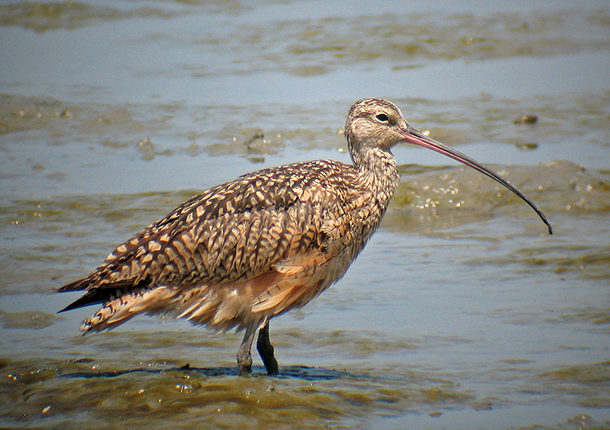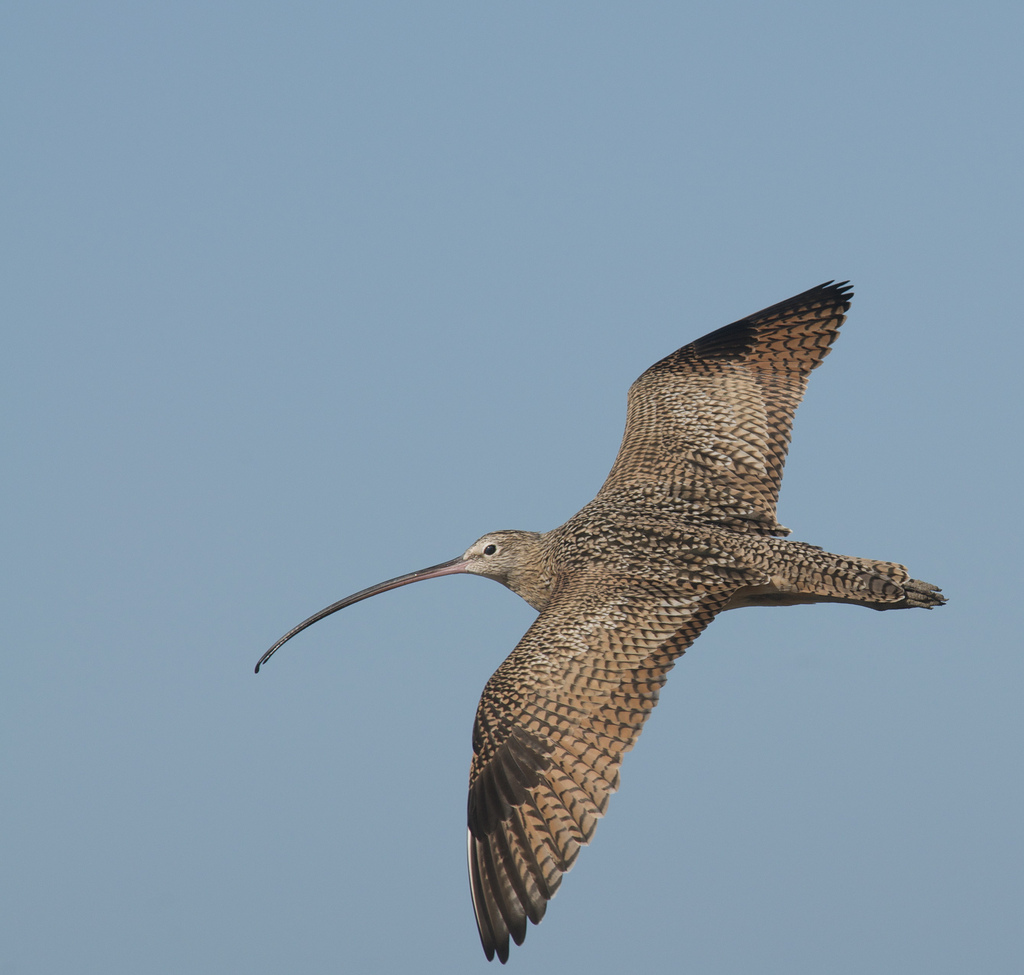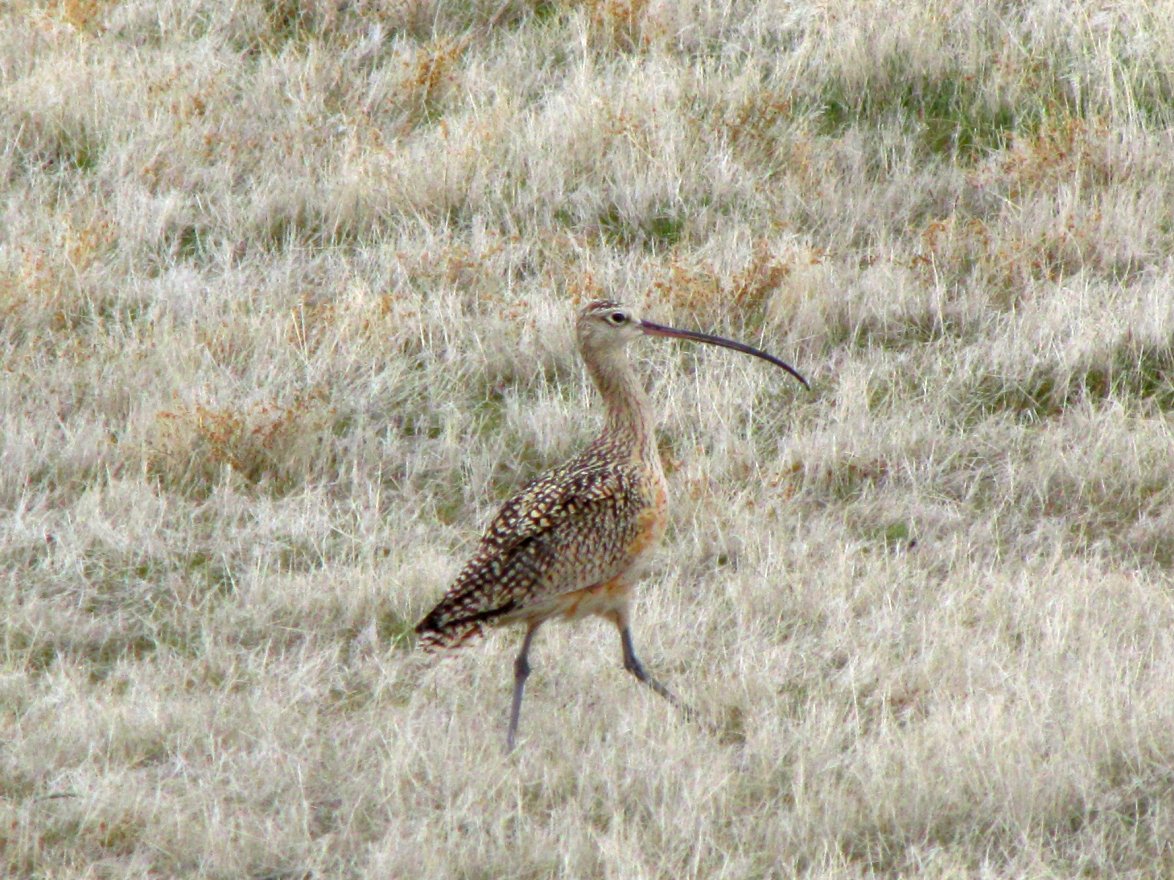BirdNote: Protecting Our Largest Shorebird
Air Date: Week of May 29, 2015

In spring, the Long-billed Curlew glides back and forth above North America's western prairies, singing for a mate. But come winter, the large, tawny birds head for warmer southern shores and Mexico. These two drastically different habitats make protecting the rare bird a challenge. Mary McCann reports.
Transcript
[MUX - BIRDNOTE® THEME]
CURWOOD: We’re staying out west for one of the most evocative of birds – at least, if you listen to its song. And as Mary McCann explains in this BirdNote®, this particular bird is facing a double set of threats.
BirdNote®
MCCANN: Singing over the Grassland
[Display song of Long-billed Curlew]
MCCANN: In spring, the male Long-billed Curlew sings his bubbling song, stitching a zigzag across the sky. Seeing it rise on rapidly beating wings, then glide down, we’re witnessing its mating display. We’re seeing North America’s largest shorebird in its breeding habitat: a western grassland.
[Display song of Long-billed Curlew]
Long-billed Curlews may be the largest, but they’re also among the rarest. Their numbers are declining as arid grasslands disappear.
Come early autumn, the curlews will depart the prairie to spend the winter in rice fields of California and on mudflats of our southern coasts. Some will continue into Mexico.

A male Long-billed Curlew soars across the skies above North America's grasslands. (Photo: Jerry Kirkhart)
[Flight calls of Long-billed Curlew]
As one ornithologist* says, “The beach is a great place to visit, but you wouldn’t want to raise a family there.” So, because curlews depend on very different breeding and wintering environments, changes in either habitat affect them.
The Nature Conservancy and American Bird Conservancy are protecting habitat in the prairies of Montana, and in Mexico, they’re working closely with Pronatura Noreste (pronounced nor-es-tay). The goal is to keep the beautiful song of the curlew in our spring skies…
[Display song of Long-billed Curlew]
…and that long, curved bill on the beach in winter.
[Flight/alarm calls of Long-billed Curlew].
I’m Mary McCann.
###
Written by Dennis Paulson
Sounds of the Long-billed Curlew provided by The Macaulay Library of Natural Sounds at the Cornell Lab of Ornithology, Ithaca, New York. Display call recorded by R.S. Little; flight call by G.A. Keller;
Flight call at beach recorded by Martyn Stewart of naturesound.org
Producer: John Kessler
Executive Producer: Chris Peterson / Dominic Black
© 2015 Tune In to Nature.org May 2015 Narrator: Mary McCann
* The ornithologist is Dr. Dennis Paulson.
Curlew in flight - Jerry Kirkhart https://www.flickr.com/photos/jkirkhart35/4015923888/
Curlew in grass - Bryant Olsen https://www.flickr.com/photos/bryanto/4518324806
Curlew on the beach - Ken Schneider https://www.flickr.com/photos/zonotrichia/5995659161
http://birdnote.org/show/long-billed-curlew-singing-over-grassland
CURWOOD: You can find pictures if you soar on over to our website, LOE.org.

Long-billed Curlew nest on grasslands, but prefer southern shores in winter. (Photo: Bryant Olsen)
Links
More about the Long-billed Curlew
Status Assessment and Conservation Action Plan for the Long-billed Curlew
Living on Earth wants to hear from you!
Living on Earth
62 Calef Highway, Suite 212
Lee, NH 03861
Telephone: 617-287-4121
E-mail: comments@loe.org
Newsletter [Click here]
Donate to Living on Earth!
Living on Earth is an independent media program and relies entirely on contributions from listeners and institutions supporting public service. Please donate now to preserve an independent environmental voice.
NewsletterLiving on Earth offers a weekly delivery of the show's rundown to your mailbox. Sign up for our newsletter today!
 Sailors For The Sea: Be the change you want to sea.
Sailors For The Sea: Be the change you want to sea.
 The Grantham Foundation for the Protection of the Environment: Committed to protecting and improving the health of the global environment.
The Grantham Foundation for the Protection of the Environment: Committed to protecting and improving the health of the global environment.
 Contribute to Living on Earth and receive, as our gift to you, an archival print of one of Mark Seth Lender's extraordinary wildlife photographs. Follow the link to see Mark's current collection of photographs.
Contribute to Living on Earth and receive, as our gift to you, an archival print of one of Mark Seth Lender's extraordinary wildlife photographs. Follow the link to see Mark's current collection of photographs.
 Buy a signed copy of Mark Seth Lender's book Smeagull the Seagull & support Living on Earth
Buy a signed copy of Mark Seth Lender's book Smeagull the Seagull & support Living on Earth

